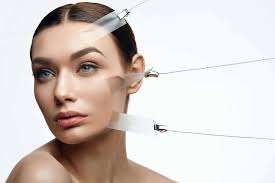
What Is a Liquid Facelift? How It Works, Benefits, Risks, and Where to Get It Done
A facelift is a surgical way to reverse the visual signs of aging on the face and neck. But there is also a noninvasive, less-risky alternative that can be performed in an outpatient setting and offers near-immediate results: a liquid facelift.
“For the right candidate, a liquid facelift is a great option to rejuvenate and enhance with minimal downtime,” explains David Shafer, MD, a plastic surgeon in New York City. The ideal candidate has minimal skin laxity (loss of skin elasticity, sagging, or deepening of skin folds), but some age-related deflation of the face, he adds.
Here’s how it works, as well as some pros and cons if you’re considering it.
What Is a Liquid Facelift and How Does It Work?
The term “liquid facelift” refers to the use of soft tissue fillers to create lifting and contouring of the face without surgery, explains Kathleen C. Suozzi, MD, the director of aesthetic dermatology at Yale Medicine and an assistant professor at Yale School of Medicine in New Haven, Connecticut. “It is not so much a defined procedure or technique as a concept,” she says.
According to the American Society of Plastic Surgeons (ASPS), the term is used for a combination of injectable procedures that can address some of the issues associated with aging, such as loss of volume or the appearance of wrinkles, without going through invasive surgery or recovery.[1]
When patients undergo a liquid facelift, they will receive numerous injections with various dermal fillers, injections, and lasers. “The type of product used and the location of injections will vary depending on patient needs and injector preferences,” Dr. Suozzi says. “In general, injections are targeted at the mid and upper face to pull tissue up and back.”
How Is a Liquid Facelift Different From a Surgical Facelift?
The major difference between a liquid and surgical facelift is invasiveness. “A liquid facelift is not surgery,” says Howard Sobel, MD, a clinical dermatologic surgeon at Lenox Hill Hospital and the founder of a private practice, Sobel Skin, in New York City.
As a result, the side effects and recovery are much milder, but so are the overall results.
“During a surgical facelift, the facial lining of the face is released and tightened. This cannot be achieved with fillers,” explains Suozzi. Experienced injectors can use a technique called subcision to release retaining ligaments during the liquid facelift procedure.
Also, the effects of a liquid facelift don’t last nearly as long as those of a traditional facelift, Dr. Sobel says: 6 to 12 months compared with 10 years or more. There is also a significant difference in cost. While the cost of a liquid facelift varies depending on the person and their needs, according to a survey of 91 RealSelf members, procedures cost on average $2,325, but can range as high as $4,000.[2]
Per the American Society of Plastic Surgeons, the average cost of a facelift is $11,395, and varies depending on the physician, your location, and personal needs.[3]
How It Works Exactly: What to Expect During a Liquid Facelift
A liquid facelift is a relatively quick outpatient procedure.
The attending physician will start by mapping out the specific areas for each patient for the best result possible, Sobel explains. “Those areas include the brow, chin, eyes, nose, cheeks, and lips to address facial contours, expression line and wrinkles, loss of volume in the cheeks, under-eye hollowness and sagging of the skin,” he says.
Before the injections, the patient will have a topical numbing cream applied to the skin for anesthesia. It’s left on for about 20 minutes or until the skin is numbed. Then the cream is cleaned off and the skin is prepped for the injections, Suozzi says.
“The injections are minimally uncomfortable and typically take around 30 minutes to perform,” Suozzi says.
What Types of Fillers and Injections Are Used?
Liquid facelifts involve a combination of fillers and injections.
Hyaluronic acid is the most commonly used filler type, Suozzi says. It’s used to treat fine lines and wrinkles, facial folds, and to create structure, framework, and volume to the face and lips.[4] “The lifting capacity of [hyaluronic acid] gels can be varied, making some fillers stiffer and better for lifting, while others are thinner and softer,” Suozzi says. Different hyaluronic acid fillers have different chemical compositions, which results in a different effects, such as making skin appear more hydrated or smoother, Dr. Shafer explains. An added safety feature of these types of fillers is that there is an enzyme that can “soften” or dissolve them, in cases when a patient isn’t happy with the results and doesn’t want to wait until they naturally dissolve over time.
Calcium hydroxylapatite is a filler that has a composition similar to bone. As part of the aging process, skin, bones, fat, and muscles in the face become thin and shift, resulting in wrinkles, folds, laxity, and volume loss.[5] The injectable calcium hydroxylapatite filler, Radiesse, is a biocompatible dermal filler that is approved by the U.S. Food and Drug Administration (FDA) to improve the appearance of moderate to severe facial wrinkles and folds, such as the nasolabial folds (the vertical creases running from the bottom of the nose to the corners of the mouth). “This makes it more structural and able to lift tissue,” Suozzi explains. “Care has to be taken with Radiesse because of the calcium content of the filler, which makes it not ideal for softer areas such as the lips and under the eyes,” says Shafer.
Poly-L lactic acid is approved by the FDA for improving the appearance of nasolabial folds, contour changes, and other facial wrinkles.[6] “It is typically used in conjunction with hyaluronic acid fillers to both lift the tissue and then to fill the face more diffusely to create a youthful appearance,” says Shafer. He adds that poly-L lactic acid fillers are more appropriate for globalized filling and not targeted structure or refinement. “It also requires several treatments but has the benefit that it is long lasting,” he says.
Botulinum neurotoxin (Botox, Dysport) may also be used to relax fine lines and wrinkles, says Sobel. “Botox is a great adjuvant treatment to help reduce the dynamic lines of the upper face and give the skin a nice glow,” adds Shafer.
What to Expect After the Procedure
After a liquid facelift, the practitioner might suggest icing the areas of injection to minimize bruising and swelling, which may last up to two weeks. “Avoid blood thinners and NSAIDs, such as aspirin and ibuprofen, two weeks before the procedure to minimize bruising risk,” Suozzi says.
You may also want to avoid exercising and sun exposure the first few days following a liquid facelift procedure, says Sobel. “Avoid harsh exfoliants and peels for about a week and wash with a gentle cleansing cream or foaming cleanser,” he adds.
Potential Benefits of a Liquid Facelift
Sobel says that while it is noninvasive and surgery-free, a liquid facelift can effectively redefine the jawline and cheekbones, lift sagging brows, diminish lines and wrinkles, and restore lost volume.
Fillers can also increase facial contours to hide puffiness and dark circles under the eyes, Sobel says. Skin is then smoothed with a laser and microneedling to promote collagen production, which helps refine and rejuvenate the skin.
While the specific areas targeted will vary by the patient, there are common injection sites for a liquid facelift, Sobel says. They include the following:
Brow
Chin
Eyes
Nose
Cheeks
“Benefits for the appropriate candidate are: customizability, short recovery, and natural-appearing results, if treated by an experienced injector,” adds Shafer.
Who Should Not Get a Liquid Facelift and Why
Because a liquid facelift is a customized and noninvasive procedure, it can be appropriate for a lot of people looking to contour and sculpt the face and restore volume for a youthful, rejuvenated look, Sobel says.
Suozzi notes that it is better suited for patients with mild to moderate facial aging. “It is not possible to achieve the same lifting results as surgery for patients with more advanced aging,” she says.
And there are some who should avoid it all together. “We do advise patients with any medical conditions, filler sensitivities, or nerve disorders to not get a liquid facelift,” Sobel says. This includes pregnant or breastfeeding people, per Mayo Clinic.[7]
Cleveland Clinic adds that anyone with neuromuscular disease, drooping eyelids, or weak facial muscles should avoid Botox, specifically.[8]
Patients with moderate to severe laxity are also not good candidates, says Shafer. “If over-aggressive fillers are used to compensate for severely loose skin, then the patient risks looking overinflated, like a balloon,” he explains.
Likewise, obese patients or those with full faces and necks often are not good candidates. “In patients with full faces or obesity, some structural fillers such as Volux and Voluma [both hyaluronic acid fillers] can add some definition — but in these patients surgical interventions such as neck liposuction and facelift are going to yield more dramatic results,” Shafer says.
How Much Does It Cost to Get a Liquid Facelift, and Who Does It?
The cost of a liquid facelift varies dramatically, based on the needs and desires of each patient, which will determine the number and type of syringes and product that is used. “On average two to four syringes are required for ideal results and the average cost per syringe is $600 to $1,500, depending on the product,” Suozzi says.
Sobel notes that in his practice the range of cost can be anywhere from $2,500 to $7,500, depending on the patient and the products required.
The liquid facelift is an advanced technique requiring a sophisticated knowledge of facial anatomy and safety with injections. “Some of the locations targeted are higher risk injection sites that could result in serious complications like blindness if not performed by an experienced injector,” Suozzi says. For this reason, patients should seek out board certified dermatologists or plastic surgeons to perform a liquid facelift.
“You absolutely do not want to go to a med spa for a liquid facelift,” says Sobel. There is nuance and art required for the procedure, he says. A physician and skilled professional who knows the anatomy of the skin and underlying muscles is the best person to give a liquid facelift.
“As a dermatological cosmetic surgeon, I have a unique perspective on how the skin functions and responds to the fillers and injectables used in the treatment, knowing exactly where to place injections for the best, most natural and contoured result,” Sobel adds.
“It cannot be emphasized enough that the skill of the injector is paramount when having a treatment,” agrees Shafer. “There are true risks with any procedure, and it’s important that you are treated in a skilled medical facility with resources for any occurrence.”
The Takeaway
A liquid facelift is the use of fillers and other injectables to lift and contour the face with little to no downtime. Botox is an example. It is a great option for anyone who has mild laxity and age-related deflation. While a single liquid facelift costs significantly less than a traditional surgical facelift, results are temporary, and you are not going to achieve the same results, especially if you need skin removed to tighten the jawline.


